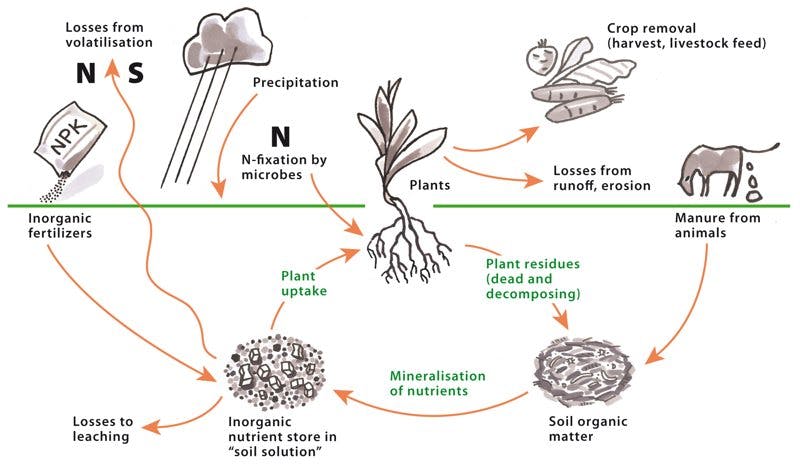
Biosolids deliver a full suite of macro- and micronutrients, making it a superior source of plant food over synthetic fertilizers. Specifically they contain large amounts of nitrogen and phosphorus along with low amounts of potassium. Biosolids also have organic matter which provides food for soil microbes, builds soil tilth, and improves overall soil health. The micro-nutrients or significance are zinc, magnesium, manganese, copper, Iron, and molybdenum, which are just as important in maintaining healthy soil to meet your high yield goals.
Why are nutrients important?
Plants, like all living things, require nutrients for growth. In nature, plants obtain nutrients from the soil. These nutrients are returned to the soil when the plant dies and decays. However, this natural cycle is interrupted when agricultural harvesting removes all or part of the plant from the land. Farmers must replace nutrients in their soil by applying a nutrient rich product such as a commercial fertilizer, manure, compost, or biosolids. The addition of nutrients to soil helps to maintain the soil health and fertility. Using biosolids as a nutrient source recycles nutrients that would otherwise be dumped in landfills or incinerated. For this reason, farmers apply NASM as nutrients for their crops and reduce the demand for commercial fertilizers. When applying NASM it is important to adjust fertilizer and animal manure rates to ensure only safe amount of nutrients are applied to the soil.

Nitrogen
Biosolids contain both organic and inorganic nitrogen. After biosolids application, the inorganic nitrogen is available immediately to crops. Organic nitrogen must be converted into inorganic nitrogen via nitrogen mineralization prior to being available to the crops.
During application of biosolids, volatilization (loss of nitrogen to the air) occurs, but with injection of biosolids, the loss is minimized; the remaining ammonia nitrogen is available to plants or converted to nitrate nitrogen.
The available nitrogen in both commercial fertilizer and biosolids could eventually find it’s way into the groundwater, which can cause a health risk to humans and animals if consumed. Strict NMA guidelines have been put in place to limit the amount of nitrogen that can be applied through biosolids. This limit will vary with crop type and application timing.
Phosphorous
Phosphorus's is essential to all vegetative life. It’s primary role is to store and transfer energy produced by photosynthesis for use in the growth and reproductive processes. Adequate phosphorus levels encourage positive effects like vigorous root and shoot growth and can promote early maturity. These effects often increase water use efficiency and potential grain yield.
Phosphorus is a main component in both commercial fertilizers and biosolids. Forty percent of the phosphorous in biosolids is released during the first year after application, the remainder is slowly released over time. Biosolids are most effective when applied to soils that are deficient in phosphorous. Soils are considered deficient when the soil has less than 60mg/l (ppm) of (sodium bicarbonate extractable) phosphorous.
Although excess levels of phosphorous are not toxic to plants, erosion of phosphorous laden soil can lead to surface water quality problems such as excessive algae and weed growth. Legislation in Ontario (Nutrient Management Act) does not permit application of biosolids where soil tests indicate the presence of more than 60 milligrams per litre (ppm) of sodium bicarbonate extractable phosphorous within the top 15 centimeters of soil.
What about organic matter?
Biosolids, especially dewater biosolids, can contain a significant amount of organic matter. Application to agricultural land can help restore organic matter that is removed from the soil by tillage and harvesting crops. Organic matter provides more space for plant roots, replenishes & maintains healthy soil, improves the circulation of water, and allows plants to take up nutrients more efficiently and increases crop productivity. Organic matter is essential for a healthy soil.
What are the fertilizer equivalencies of nutrients in biosolids?
Nitrogen, Phosphorus and Potassium are essential nutrients for plant growth. These nutrients are predominant in biosolids, but may vary depending on the treatment process, storage and type of biosolids that are applied. Biosolids are treated in such a way that the nutrients in a product will also fluctuate from day-to-day so an average of sample analysis is needed to measure the correct amount.
Only a portion of the nutrients applied are available within the first year. Below is a calculated average of what the benefits of biosolids may look like on a typical field within the first year of biosolids application: